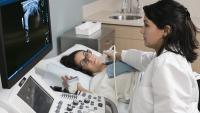Ultrasound

Make an Appointment
We have locations throughout Manhattan and Westchester. View all locations and contact info.
Ultrasound imaging (also called sonography) uses sound waves to create images of internal organs, structures, and tissues. The sound waves are transmitted by a handheld device known as a transducer, which sends short pulses of sound waves into the body. As these waves reflect, or echo, back from the internal tissues, they are sent to a computer that transforms them into a visual image.
Diagnostic ultrasound is used help determine the causes of pain, swelling, and infection in the body's internal organs. It can also be used to guide procedures, such as a breast biopsy. Musculoskeletal ultrasound is used to diagnose orthopedic and sports injuries by looking at real-time images of muscles, tendons, ligaments, nerves, and cartilage.
How do I prepare for the test?
- Check in for your appointment on the Connect patient portal. You may also check in when you arrive at the imaging center.
- On the day of the test wear comfortable clothes, and you may be asked to change into a gown when you arrive at the ultrasound exam site.
Preparation for specific ultrasound tests
| Abdomen | Nothing to eat or drink except water for 6 hours before your exam |
|---|---|
| Aorta | No preparation |
| Bladder | Drink 5-6 glasses of water 1 hour before your exam |
| Breast | No preparation |
| Extremity | No preparation |
| Gall Bladder | Nothing to eat or drink except water for 6 hours before your exam |
| Sonohysterogram |
Please call our office on the first day of your next period to schedule an appointment for 2 days after the bleeding stops. No sexual intercourse during this time until after the procedure. No solid food for 1 hour prior to the test. Inform usof any prior reactions to iodinated contrast (“iodine dye”). |
| Kidney |
Drink 5-6 glasses of water 1 hour before the exam. |
| Liver |
Nothing to eat or drink except water for 6 hours before your exam. |
| Pancreas |
Nothing to eat or drink except water for 6 hours before your exam |
| Pelvis |
Drink 3-4 glasses of water 1 hour before the examination. Do not urinate prior to the exam. |
| Scrotum | No preparation |
| Spleen |
Nothing to eat or drink except water for 6 hours before your exam |
| Thyroid | No preparation |
| Transvaginal Pelvis | No Preparation |
What will happen during the test?
During an ultrasound the sonographer will ask you to lie on the exam table. He/she will cover the skin over the area to be examined with a small amount of warm gel to prevent air pockets from forming between the transducer and skin. The sonographer will then glide the transducer over your skin to capture the images of the tissues below, which the transducer then sends to a computer.
An ultrasound exam is typically painless, and takes about 20-30 minutes to complete.
Are there any risks?
Ultrasound does not require the use of ionizing radiation, special dyes, or anesthesia and is a safe diagnostic tool with no known risks or side effects.
After the test
After the exam you can immediately resume your normal activities. A radiologist will analyze the ultrasound images and will share the results with the doctor who requested the exam. Your doctor will then discuss the results with you.

